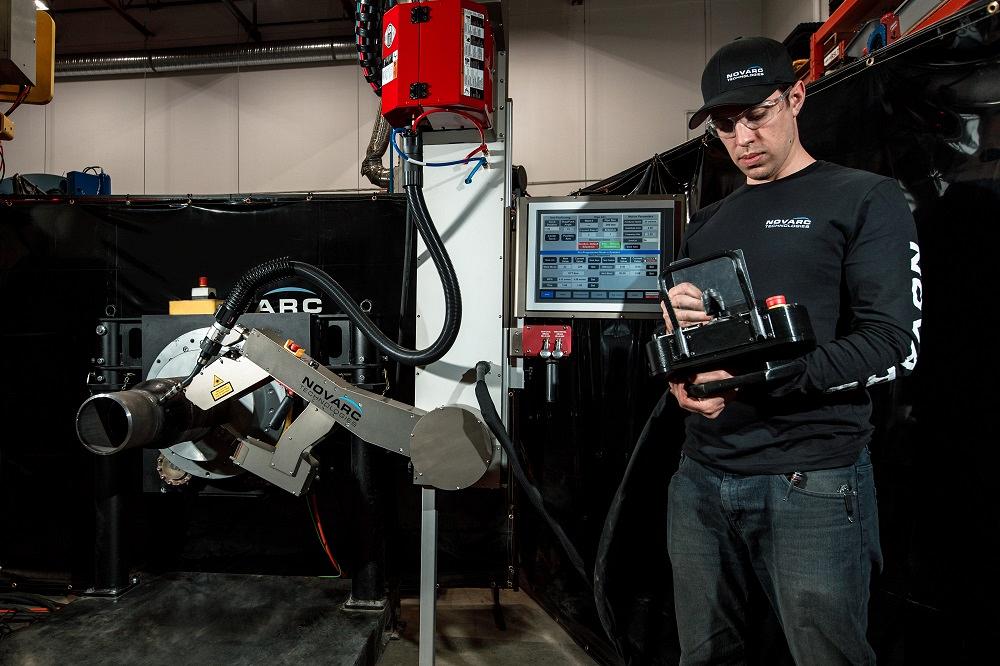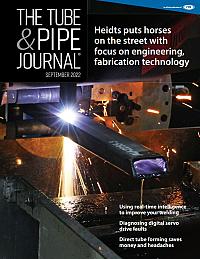Editor
- FMA
- The Fabricator
- FABTECH
- Canadian Metalworking
Categories
- Additive Manufacturing
- Aluminum Welding
- Arc Welding
- Assembly and Joining
- Automation and Robotics
- Bending and Forming
- Consumables
- Cutting and Weld Prep
- Electric Vehicles
- En Español
- Finishing
- Hydroforming
- Laser Cutting
- Laser Welding
- Machining
- Manufacturing Software
- Materials Handling
- Metals/Materials
- Oxyfuel Cutting
- Plasma Cutting
- Power Tools
- Punching and Other Holemaking
- Roll Forming
- Safety
- Sawing
- Shearing
- Shop Management
- Testing and Measuring
- Tube and Pipe Fabrication
- Tube and Pipe Production
- Waterjet Cutting
Industry Directory
Webcasts
Podcasts
FAB 40
Advertise
Subscribe
Account Login
Search
AI improves welding performance
Control uses machine learning to make automation more valuable for all fabrication shops
- By Lincoln Brunner
- September 13, 2022
- Article
- Testing and Measuring

People operating a machine run by the NovEye system don’t necessarily need to be certified welders to help deliver quality welds.
Chaos theory says that unpredictability is a constant. If it needed evidence, then welding—with its long list of shifting variables—could be Exhibit A.
While a welding operation is navigating all those variables to produce clean welds, it also needs speed to stay competitive. However, simple automation often isn’t enough to keep up with the speed and sophistication of modern robotic welding technology. That’s where taking the leap into truly smart automatic welding control systems could prove the difference for shops of many sizes.
Driving Speed and Quality Control
Every welder knows how to adjust basic parameters such as amperage, shielding gas, and line feed speeds according to different base materials, root gaps, and other variables.
However, fully manual welding simply isn’t an option for higher-turnover jobs: Bidding competitively for new jobs often increasingly means using some level of automation. What level, exactly? That all depends, but what’s certain is that preprogramming weld parameters never covers all the variables at play.
More than mere quality assurance, it is welding’s fundamental unpredictability that Novarc Technologies wants to help fabricators master with the NovEye vision-based, artificial intelligence (AI)-guided control system on its latest Spool Welding Robot (SWR). And while the orbital welding that the SWR does is nothing new, the AI and machine learning Novarc is using to drive the unit is. So noted Dr. Mahyar Asadi, vice president of innovation at Novarc Technologies, North Vancouver, B.C.
“Welding by its nature comes with lots of factors that are changing,” Asadi said. “More randomly, there’s a fluctuation in those variables. It has a direct effect on the quality of the weld.
“Everyone knows when you preprogram something, your weld comes with distortion,” he added. “When you start welding, parts are moving from the original position. The longer you go, the larger the parts you are welding, you are deviating more and more from your preprogram status, and it’s hard to predict which direction your part is going to move.”
Because not every shop’s needs are the same, Novarc offers different levels of automation, from simple mechanized welding to automated systems to smart machines that can learn better procedures over the course of time based on the data they record.
“We ultimately go for the smart machine,” Asadi said. “To keep the quality consistent and at the highest speed and productivity, then I think … the only solution you have is the automation and the intelligence to make sure you’re reacting.
“The more modern thinking is looking at those variations in real time,” he added. “The vision system looks at … the arc and all the weldment geometry that’s right under the arc, analyzes it, extracts features, and makes a proper adaptive decision to change the motion and parameters for that instance of time right under the welding.”

The NovEye control system on Novarc Technologies’ Spool Welding Robot is designed to learn from the best human welders and also to adjust to real-world variables using its optical scanning and machine learning capabilities.
Responding to Variables
For example, NovEye can perform tack detection in an open-root weld, say, between two pipes. The parameters needed for the SWR to do a clean weld in an open root are different from welding over the tack.
When an operator sets the machine, the vision system looks at the groove and keeps track of the open root, but the control system also is set to detect the tack. When the vision system detects a tack going under the weld, it switches the machine settings in real time to accommodate the tack. When it has passed over the tack, the system switches the recipe, as it were, back to open-root settings.
“Distortion is already built into the image, because that’s a real image of the part at the time of welding,” Asadi said. “That’s how we can tackle and solve the problem from prescanning.”
In addition, by studying the data from manual welding on certain materials within certain parameters, Novarc’s system can learn from the habits of those human welders as it records their welding procedures. Then, when the machine encounters those same parameters again on an automated job, it already has the information it needs to perform the weld as successfully as the people did. In the end, the machines are simply mimicking the best teachers—people.
“The artificial intelligence that we put in the brain of the system replicates or learns from the skill of human welders,” Asadi said. “They learn and replicate the most skillful welders—how they behave and how they react to different variations. There is a continuous improvement in the background … to make sure we are putting the most skillful welders’ skills into the system.”
That accumulated knowledge allows businesses that may lack certified welders to simply put welding operators at the controls of the SWR and still meet ASME codes (or any others) that require welder certification.
“When it comes to a machine like this, they fall under the mechanized welding requirements,” Asadi said. “That means they only need to be certified as a welding operator. As long as the person is qualified under code as a welding operator, the code allows them to stand by this machine and deliver the weld.
“Finding welders with all those certifications is hard and becoming harder and harder. It’s easier to find and train a weld operator rather than a welder. The operator doesn’t do any welding.”
Behind that simplicity is hundreds of years’ worth of combined welding knowledge programmed into the NovEye. The missing link between that knowledge and the inevitable wild-card variables encountered in any given welding job is the ability to adjust in real time. And once a learning machine has observed and recorded enough real-world situations, it can be trusted to deliver quality welds over and over.
“Welding science and engineering … includes many disciplines—from physics, plasma, electronics, electrical engineering, and material science,” Asadi said. “All that comes together in a small arc in the weld tool that you are seeing in the tip of the electrode. There are many sciences going on in that small portion. When you formulate something and you understand the physics behind it and all the governing equations, regardless of how complicated the process is, they are more or less following those governing equations.
“Yet, that’s not the whole process because there’s always a gap between the physics of any problem and the actual performance in the field because there are many factors that are not built into all the equations. Those need to be added to your process and to your calculation. And that’s the role of this machine learning.”
About the Author

Lincoln Brunner
2135 Point Blvd.
Elgin, IL 60123
(815)-227-8243
Lincoln Brunner is editor of The Tube & Pipe Journal. This is his second stint at TPJ, where he served as an editor for two years before helping launch thefabricator.com as FMA's first web content manager. After that very rewarding experience, he worked for 17 years as an international journalist and communications director in the nonprofit sector. He is a published author and has written extensively about all facets of the metal fabrication industry.
About the Publication
Related Companies
subscribe now

The Tube and Pipe Journal became the first magazine dedicated to serving the metal tube and pipe industry in 1990. Today, it remains the only North American publication devoted to this industry, and it has become the most trusted source of information for tube and pipe professionals.
start your free subscription- Stay connected from anywhere

Easily access valuable industry resources now with full access to the digital edition of The Fabricator.

Easily access valuable industry resources now with full access to the digital edition of The Welder.

Easily access valuable industry resources now with full access to the digital edition of The Tube and Pipe Journal.
- Podcasting
- Podcast:
- The Fabricator Podcast
- Published:
- 04/16/2024
- Running Time:
- 63:29
In this episode of The Fabricator Podcast, Caleb Chamberlain, co-founder and CEO of OSH Cut, discusses his company’s...
- Trending Articles
Team Industries names director of advanced technology and manufacturing

3D laser tube cutting system available in 3, 4, or 5 kW

Corrosion-inhibiting coating can be peeled off after use

Zekelman Industries to invest $120 million in Arkansas expansion

Brushless copper tubing cutter adjusts to ODs up to 2-1/8 in.

- Industry Events
16th Annual Safety Conference
- April 30 - May 1, 2024
- Elgin,
Pipe and Tube Conference
- May 21 - 22, 2024
- Omaha, NE
World-Class Roll Forming Workshop
- June 5 - 6, 2024
- Louisville, KY
Advanced Laser Application Workshop
- June 25 - 27, 2024
- Novi, MI


























